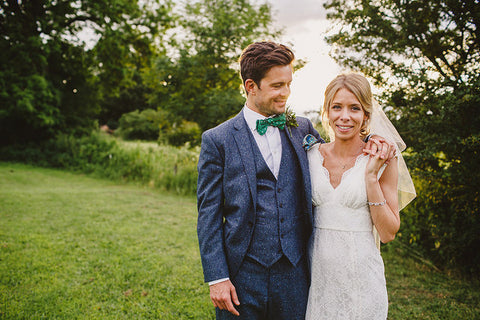
Bespoke tailoring gives you an unparalleled level of freedom: you can create a suit in whatever colour, style and fit that you desire. You can even opt to have a suit made that features a pattern of your choosing. However, patterned suits are amongst the most difficult garments to ‘carry off’ properly. Should the pattern appear only on the blazer, or should it be used on the waistcoat and trousers of the suit, too? What colour shirt should you wear with a suit whose pattern incorporates multiple different colours? How pronounced should the pattern actually be? These haunting questions can be a major obstacle to gentlemen who want to wear patterned suits. Luckily, we’re here to help you answer them.
Firstly, let us consider whether you should confine your desired pattern to the blazer or use it on all components of your suit. It is perfectly acceptable for the trousers and waistcoat to feature the same design as the blazer. However, for more flamboyant patterns, you may prefer to restrict the design to the blazer and wear a pair of plain black or white trousers (depending on whether the base-colour of the pattern is dark or light) and forgo the waistcoat altogether. There are no particular rules on the issue, so you must use your common sense and good judgement. Think about the pattern you have chosen: if it might be visually overwhelming when used across a whole suit, restrict it to the blazer. Otherwise, feel free to use it on each component of the suit: doing so can make a powerful statement.
But what type of shirt should you wear with the ensemble? Obviously, you should avoid patterned shirts at all costs: they’ll either clash with the pattern on the suit or distract from it. However, you should also avoid shirts in bold ‘block’ colours. As the pattern of your suit may include multiple colours, adding a colourful shirt to the outfit will only make it appear garish and uncouth. Instead, select a plain white or black shirt: these colours are generally more neutral and won’t have any negative on the rest of the outfit. If you’re wearing either white or black trousers, however, you should ensure that the shirt is in the opposite colour. While black and white are both sartorially neutral shades, too much of either can still be distracting and visually displeasing when worn with a pattern. After all, you want the pattern to be the main focus of your outfit, not the colour of your shirt and trousers.
Finally, you need to think about how pronounced to make the pattern on your bespoke suit. Simple, subtle patterns should be presented with as little fanfare as possible: they should be rendered in hues that are similar to the base-colour of the suit and you should neither raise nor emboss them to any significant extent. By comparison, more elaborate, complicated patterns should be as pronounced as possible: they should use vibrant colours and may be raised, embossed or even embroidered. After all, there’s no point selecting an ostentatious pattern and then diminishing its effect with muted colours and restrained design choices!
By following these simple guidelines, you should be able ‘carry off’ the patterned suit with confidence and aplomb.
